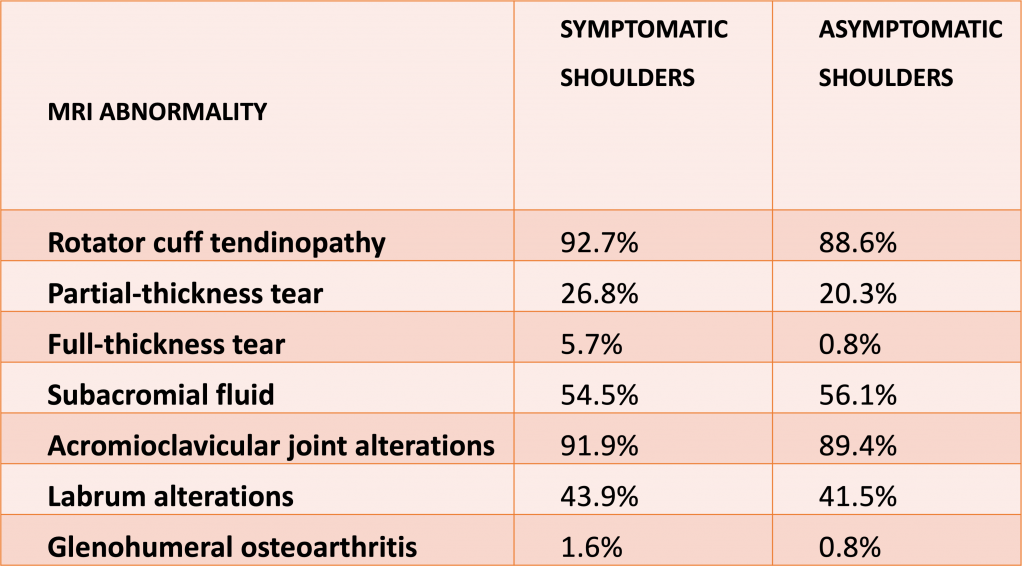HIGH PREVALENCE OF PATHOLOGIC FINDINGS ON RMN IN BOTH SHOULDERS OF THE SAME PERSON WITH UNILATERAL SHOULDER PAIN
In a 2019 study, a group of researchers (Barreto et al., 2019), compared and determined the pathological findings visualized in magnetic resonance imaging (MRI) performed on both shoulders in patients with unilateral shoulder pain.
The sample consisted of 123 patients (246 shoulders) with the following characteristics:
- Chronic intermittent unilateral shoulder pain.
- Lateral or anterolateral shoulder pain increases with movement.
- Mean duration of pain is 35.8 months.
- Mean age is 39.4 years.
MRI images of both shoulders (symptomatic and asymptomatic shoulder) were obtained in all patients and the following results were obtained:
The results of this study demonstrate that there is a high prevalence of alterations visualized in MRI not only in the symptomatic shoulder but also in the asymptomatic shoulder. In this study, small differences were observed between both shoulders.
In addition, pathologic findings on MRI were more frequent at older ages.
However, only some findings (complete tendon ruptures and glenohumeral osteoarthritis) were more appreciated in symptomatic shoulders.
PERSONAL OPINION AND CLINICAL COMMENTS
As we can see, according to the results of this interesting study, the findings visualized in an MRI do not justify the symptoms presented by a patient. However, one of the most widely used models in the decision making in health professions is still the pathoanatomical model that tries to identify the structure responsible for the symptoms.
If, for example, we put the images of twenty MRI scans on a wall to a physician without having more data on the patient, he or she would not be able to know who has shoulder pain and who does not. Many of the findings found in an MRI may be coincidental and not the reason for the symptoms presented by the patients.
Furthermore, the appearance of a pathologic finding on an MRI is neither a sufficient nor a necessary condition for a patient to present with shoulder pain. It seems that psychosocial factors are largely to blame, so the model of thinking that should be used much more would be the biopsychosocial one.
In my clinic, more and more patients come with a medical diagnosis based solely on an MRI. When you ask them, they tell you that they have not had their shirts removed for an examination or anamnesis, so the MRI, which is a complementary test, becomes the main diagnosis of the patient's problem. There are classic studies that state that the main working hypothesis is obtained during the clinical interview (Roshan & Rao, 2000; Sackett, 1992; Somerville et al., 2017), and it is during the physical examination that this hypothesis is confirmed. MRI in this case would complement this hypothesis.
The usefulness of MRI remains in doubt in some cases, especially when the treatment does not change.
Physiotherapy treatment should be based on the dysfunctions found in each patient individually, addressing different components or dimensions, i.e., not only focusing on bio factors (e.g., hyperalgesia) but also on psychosocial (beliefs, behaviour, emotions, work, etc.) and lifestyle (physical activity, sleep, alcohol, tobacco, etc.) factors.
REFERENCES
Barreto, R. P. G., Braman, J. P., Ludewig, P. M., Ribeiro, L. P., & Camargo, P. R. (2019). Bilateral magnetic resonance imaging findings in individuals with unilateral shoulder pain. Journal of Shoulder and Elbow Surgery, 28(9), 1699–1706. https://doi.org/10.1016/j.jse.2019.04.001
Roshan, M., & Rao, A. P. (2000). A study on relative contributions of the history, physical examination and investigations in making a medical diagnosis. The Journal of the Association of Physicians of India, 48(8), 771–775.
Sackett, D. L. (1992). The Science of the Art of the Clinical Examination. JAMA: The Journal of the American Medical Association, 267(19), 2650. https://doi.org/10.1001/jama.1992.03480190092040
Somerville, L., Willits, K., Johnson, A., Litchfield, R., LeBel, M.-E., Moro, J., & Bryant, D. (2017). Diagnostic Validity of Patient-Reported History for Shoulder Pathology. The Surgery Journal, 03(02), e79–e87. https://doi.org/10.1055/s-0037-1601878
#IMTA#MaitlandConcept#MusculoskeletalPhysiotherapy#ClinicalReasoning#TheShoulder#LadislaoCamposFisioterapia





Comments